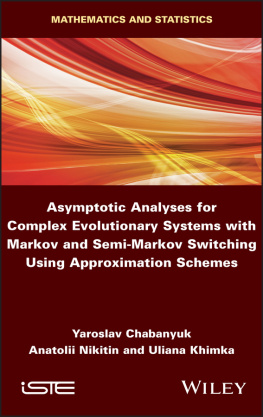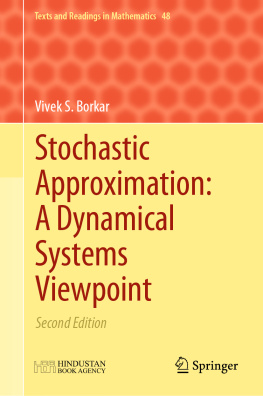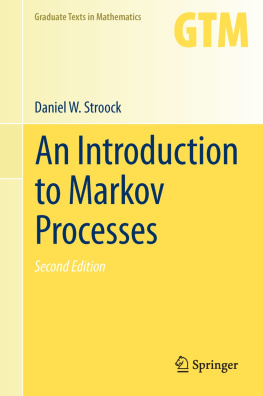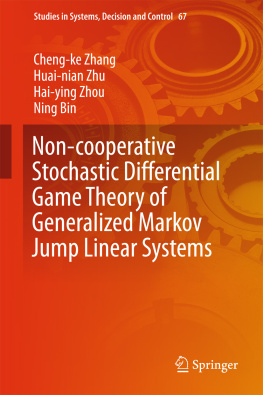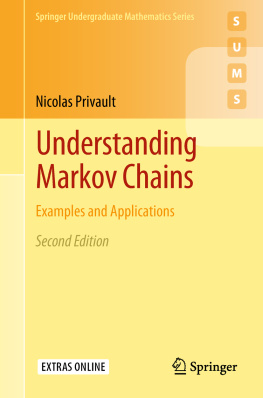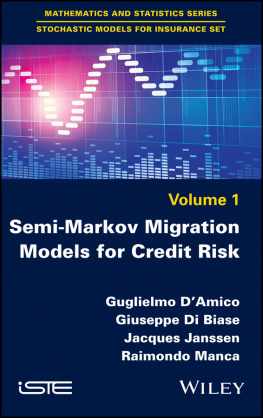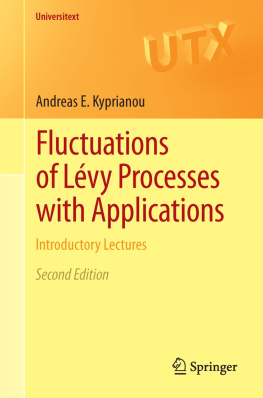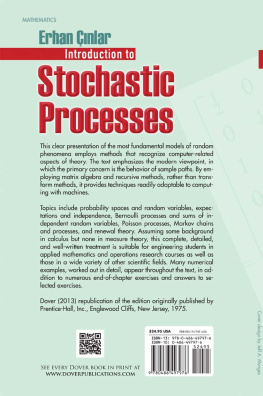
To our teachers
Series Editor
Nikolaos Limnios
Asymptotic Analyses for Complex Evolutionary Systems with Markov and Semi-Markov Switching Using Approximation Schemes
Yaroslav Chabanyuk
Anatolii Nikitin
Uliana Khimka

First published 2020 in Great Britain and the United States by ISTE Ltd and John Wiley & Sons, Inc.
Apart from any fair dealing for the purposes of research or private study, or criticism or review, as permitted under the Copyright, Designs and Patents Act 1988, this publication may only be reproduced, stored or transmitted, in any form or by any means, with the prior permission in writing of the publishers, or in the case of reprographic reproduction in accordance with the terms and licenses issued by the CLA. Enquiries concerning reproduction outside these terms should be sent to the publishers at the undermentioned address:
ISTE Ltd
2737 St Georges Road
London SW19 4EU
UK USA
www.iste.co.uk
John Wiley & Sons, Inc.
111 River Street
Hoboken, NJ 07030
USA
www.wiley.com
ISTE Ltd 2020
The rights of Yaroslav Chabanyuk, Anatolii Nikitin and Uliana Khimka to be identified as the authors of this work have been asserted by them in accordance with the Copyright, Designs and Patents Act 1988.
Library of Congress Control Number: 2020936535
British Library Cataloguing-in-Publication Data
A CIP record for this book is available from the British Library
ISBN 978-1-78630-556-5
Acronyms
| SDE | Stochastic Differential Equation |
| IPP | Impulse Perturbation Process |
| MP | Markov Process |
| SMP | Semi-Markov Process |
| SAP | Stochastic Approximation Procedure |
| SOP | Stochastic Optimization Procedure |
| MRP | Markov Renewal Process |
| EMRP | Extended Markov Renewal Process |
| SSPP | Solving of Singular Perturbed Problem |
Introduction
The emergence of the theory of stochastic differential equations played a prominent role in the works of S.N. Bernshtain, M.M. Bogolyubov and M.M. Krylov. A systematic study of stochastic differential equations was first carried out by Y.I. Gichman. The concept of random evolution was introduced by Griego and Hersh (1969) and Bellman (1957).
Applications of such a model were derived from the work of Feng (1999), Fleming and Soner (2006), Feng and Kurtz (2006), which were stimulated by the problems of the stability of stochastic systems.
In the 1960s and 1970s, the problems associated with the theory of random evolution were actively investigated by American mathematicians R. Hersch, M. Pinskii, G. Papanikolau, T. Kurtts, R. Griego, L. Horossey (Skorokhod 1989; Sviridenko 1998; Skorokhod et al. 2002; Samoilenko et al. 2017) and others. In particular, G. Papanikolaou, D. Stroock and S. Varadan proposed a martingale approach for the proof of boundary theorems (Papanicolaou et al. 1977), Stroock using methods similar to solving the singular perturbation problem.
An effective means to prove the limit theorems in the theory of random evolution was developed by Korolyuk and Turbin (1993). Thanks to their methods, A.F. Turbin, O.S. Hochhel and other authors proved important boundary theorems on regular approximations for singularly perturbed solutions of differential equations for different stochastic models, as well as for dynamical systems with coefficients dependent on Markov processes (Feng and Kurtz 2006). Skorokhod (1989), V.E. Shapiro and V.M. Login investigated several important problems of the theory of dynamical systems described by stochastic differential equations. The problem of the stability of dynamical systems with random disturbance of their parameters was investigated by Gorostiza (1972, 1973a, 1973b), E.F. Tsar'kov and V.S. Korolyuk. Problems of stability and of the stochastic approximation of evolution systems with switches were investigated by Y.M. Chabanyuk and in the works of Kurtz (1973, 1987), Donsker and Varadhan (1975a), Papanicolaou (1975), Korolyuk and Turbin (1993) and Koroliuk et al. (2010a). V.S. Korolyuk and A.V. Svishchuk also developed the theory of semi-Markovic random evolution, based on the theory of martingales. Many applications of switching processes to the analysis of network systems can be found in the works of V.V. Anisimov (Bainov and Simeonov 1992; Albeverio et al. 2008, 2009; Anisimov 2008). Samoilenko I.V. (Albeverio et al. 2008, 2009) studied the Markov processes with impulse disturbances in approximation schemes.
Methods of studying the asymptotic properties used in the dissertation have been described in the monographs of Korolyuk and Limnios (2005) and Skorokhod. These methods are mainly applied to models in averaging and diffusion approximation schemes (Chabanyuk et al. 2007). At the same time, with a growing time interval, the averaging scheme demonstrates the deterministic averaged behavior of the system, and the scheme of diffusion approximation is stochastic fluctuations around a deterministic averaged trajectory. These two schemes differ in the normalization of the switching process, namely, in the case of the averaging scheme, the acceleration of time is considered by the parameter -1, whereas in the case of diffusion approximation, it is considered by the parameter -2. An important element of the algorithm is the assumption that the switching process is ergodic.
Note that the main ideas of the random process have been presented in the works of Cramer (1938), Cole (1951), Chernoff (1952), Bellman (1957), Dolans-Dade and Meyer (1970), Papanicolaou (1971a, 1971b, 1973), Hersh (1974), Roth (1974), Cinlar et al. (1980) and Doob (1990). Works on the problem of large deviations should be singled out: Freidlin (1978), Ethier and Kurtz (1985), Deuschel and Stroock (1989), Bryc (1990), Dembo and Zeitouni (1993), Mogulskii (1993), O'Brien and Vervaat (1995), Dupuis and Ellis (1997) and Koroliuk and Samoilenko (2014).
Tasks of weak convergence of the random process have been presented in the works of Kushner (1990) and Kolesnik (2001, 2003).
The application of stochastic differential equations has been presented in the following works: Hopf (1950), Pinsky (1968), Papanicolaou and Kellek (1971), Papanicolaou and Hersh (1972), Nashed (1976), Papanicolaou et al. (1977), Crandall and Lions (1983), Fukushima and Stroock (1986), Protter (1990), Puhalskii (1991), Davis (1993), Dellacherie and Meyer (1993), Devooght (1997), Hillen (2001), Othmer and Hillen (2002), Hersh (2003), Jacod and Shiryaev (2003) and Orsingher and Sommella (2004).
In the monographs of Korolyuk and Korolyuk (1999) and Limnios and Oprian (2001), the classification of stochastic models has been considered. In the works of Korolyuk and Chabanyuk (2002) and Chabanyuk (2007), stability conditions of the dynamic system with semi-Markov switchings have been established in the average scheme and the diffusion approximation scheme. The fluctuations of such system have been considered in the paper by Chabanyuk et al. (2007).
A natural generalization of the stochastic approximation procedure (Nevelson and Khasminsky 1972) is an examination of the case where the regression function is directly dependent on an external environment with Markov or semi-Markov switching (Chabanyuk 2004a, 2004b, 2019). For the stochastic optimization procedure (Khimka and Chabanyuk 2013), sufficient conditions are obtained for convergence with Markov switching. The properties of the compensating operator of random evolution are used in the case of semi-Markov switching (Sviridenko 1998).
Next page
